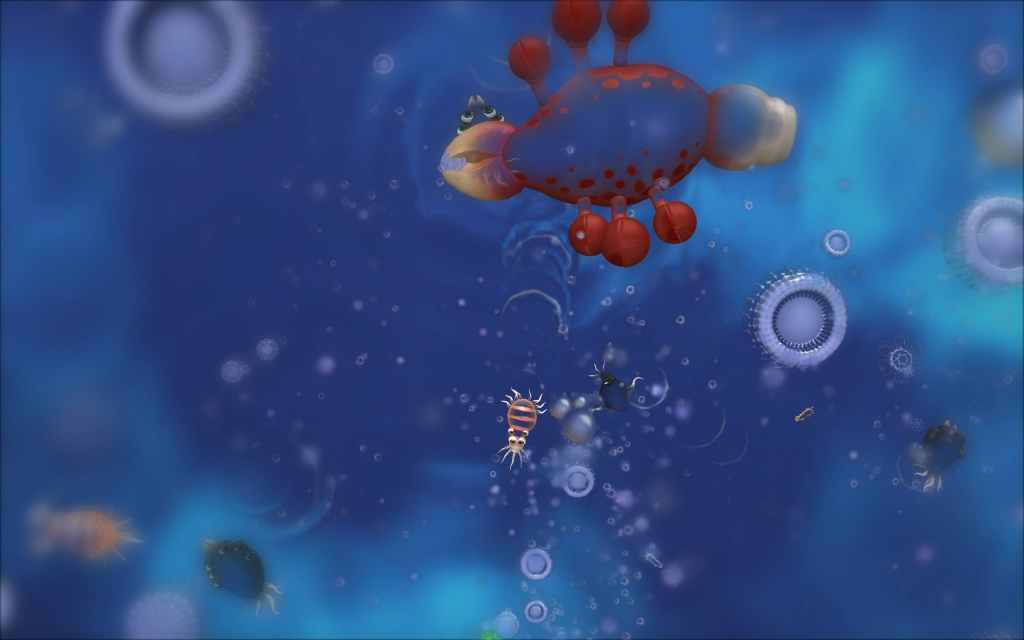When I started my playthrough of Spore, I was genuinely excited to return to a game I remembered as a creative powerhouse. My species, the Hammodians (a goal-obsessed, winged ape-like offshoot of the Hork-Bajir from Animorphs), began their journey with one clear philosophy: “We’re either friends, or you’re extinct.”
The First Half Is a Triumph: Addictive and Ahead of Its Time

The opening hours of Spore still feel like a blueprint for an entire subgenre of modern games. Creation, survival, and evolution, all baked into a loop that’s surprisingly addictive, even today.
Cell Stage: Short and Sweet
The Cell Stage is a great on-ramp. Simple, chaotic, and visually fun, especially as you start dodging or devouring larger lifeforms in the soup. I rolled with an omnivore strategy, which ended up being the fastest path forward: speed to compete, jets to escape, and just enough teeth to keep rivals in check. It’s over quickly, but that’s not a bad thing. It’s a clean, fast-paced intro that clearly inspired stuff like Agar.io, Slither.io, and Hungry Shark Evolution.
Creature Stage: The Core of the Experience

This is the part of Spore everyone remembers, and for good reason: it still slaps. The Creature Creator is intuitive and fun, and it actually feels like your design choices matter. I shaped the Hammodians into fast, mobile predators (lean, bipedal, and eventually winged), and used socializing to climb the evolutionary ladder. Yeah, the “Simon Says” dance system is a bit goofy, but it works well enough to make progress feel rewarding. There’s a great sense of scale as you push further from the starting shore. Evolution has real momentum here. It’s not perfect, but it’s compelling in a way that most “evolution games” still haven’t topped.
The Second Half Slams on the Brakes
And then… you hit the Tribe Stage. This is where Spore goes from “genre-defining” to “why am I still playing this?”
Tribe Stage: A Sudden, Awkward Pivot
The switch from Creature to Tribe is so jarring it feels like loading a different game entirely. One moment you’re evolving, adapting, and exploring, next thing you know, you’re dressing your creature in a loincloth and assigning it to gather fruit. You lose all ability to evolve your species biologically. Instead, it turns into a rudimentary strategy/resource management game, one that doesn’t even do those things well. Socializing and combat become flat, repetitive loops. The charm and creative freedom of the first two stages? Completely gone. I’ll be blunt: this stage kind of killed my excitement. It’s not that it’s just different: it’s that it’s worse, and it drags the whole game down with it.
Final Verdict
I powered through the first two stages, only to hit a wall in the third, and I came away with a pretty definitive answer to the question: Does Spore hold up? The verdict: The first half is still an all-time great. The second half? Shallow, clunky, and honestly, a bit of a slog. Spore is still one of the most ambitious games I’ve ever played, and that ambition is both its greatest strength and its fatal flaw. The first half of the game is iconic. It’s the reason people still talk about Spore today. The sense of progression, the creative freedom, the feeling of watching your creature become something unique, it all holds up beautifully. That part of the game deserves the praise it gets. But once you hit the Tribe Stage, it’s like the soul of the game just vanishes.
The back half is clunky, outdated, and feels like an entirely different, and much worse, game stapled onto a classic. So here’s the move: play the first two stages. Have fun evolving, customizing, and watching your weird little creature become a dominant species. And when it tells you to build a hut and start gathering food? That’s your cue to uninstall. The fun part is already over.

